Apple iPhone 14 Pro vs iPhone 14: one is new, the other is not
Intro
- Same shape and size
- iPhone 14 comes in vibrant, fun colors, Pro models are more muted and classy
- iPhone 14 is lighter, Pro has a heavier stainless steel frame
- 60 Hz on iPhone 14, 120 Hz on iPhone 14 Pro
- iPhone 14 staying with A15 Bionic, iPhone 14 Pro upgrading to A16 Bionic
- iPhone 14 Pro has 2x crop zoom and 3x telephoto lens
- iPhone 14 Pro has LiDAR sensor for Augmented Reality and measurements
- iPhone 14 Pro has new 48 MP camera, non-Pro retains 12 MP
- Battery life should be about the same
Table of Contents:
Design and Display Quality
Same screens, but one is smoother
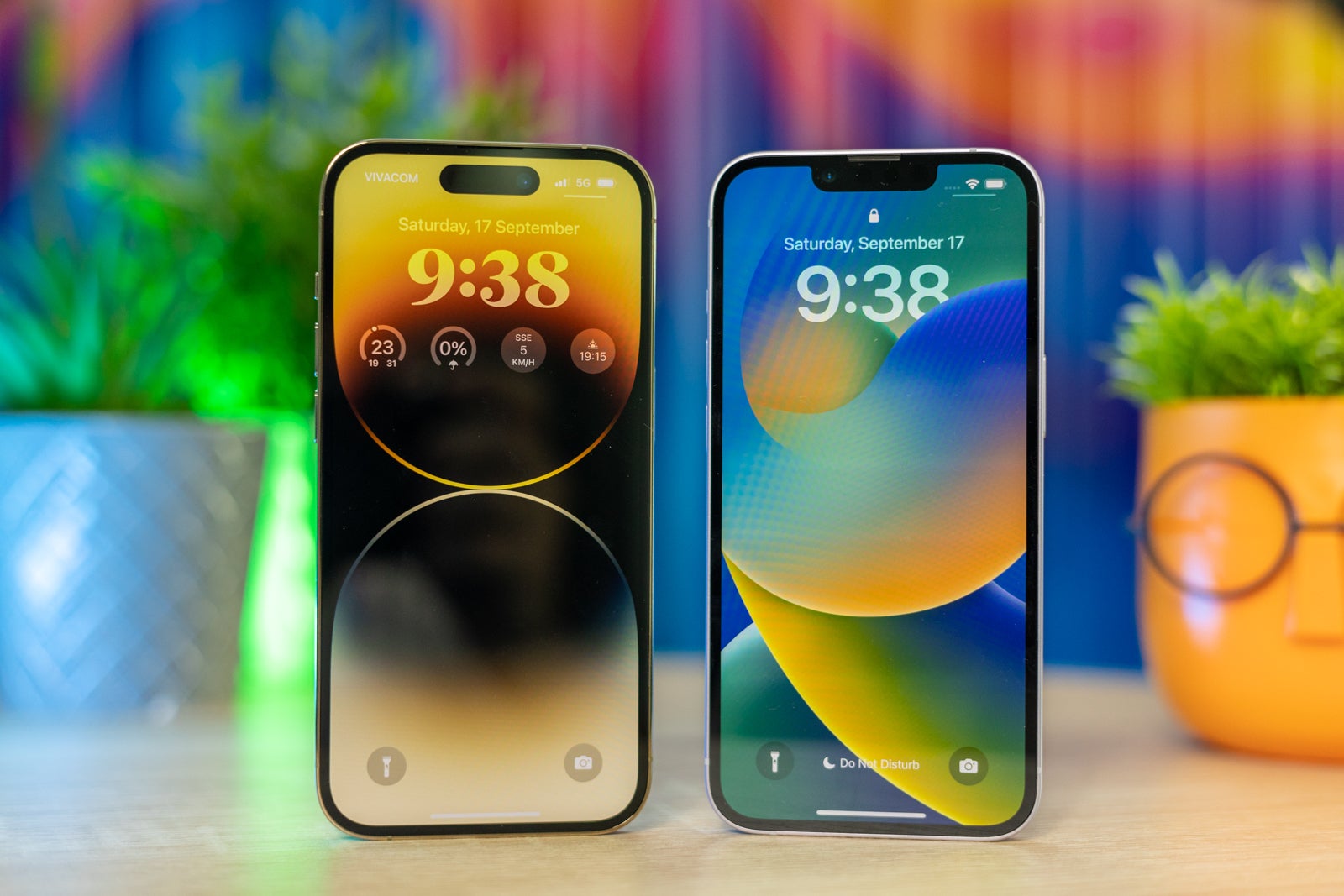
(Image Credit – PhoneArena) iPhone 14 Pro vs iPhone 14
Both the iPhone 14 and iPhone 14 Pro have similar dimensions, and both have the same 6.1-inch screen size. They are OLED panels, built to Apple’s spec, but — as we know — the Pro has a 120 Hz refresh rate for super-smooth animations, whereas the non-Pro sticks to 60 Hz. The latter is kind of a low-ball, considering that — in 2022 — even midrange smartphones ship with at least 90 Hz.
Does it improve the experience over the classic Notch? Eh… kind of, maybe, in the sense that you get some extra widgets for multitasking. But there’s still a camera cutout in the top-middle of the screen to eat into your content. Naturally, we expect to see the same divide between tech fans as before — some will hate it, other’s won’t mind it.
The iPhone 14 sticks with the slimmed down notch, the same shape we saw on the iPhone 13.
Another difference is the inclusion of always-on display — the iPhone 14 Pro’s LTPO screen can go all the way down to a 1 Hz refresh rate. Apple included always-on functionality within iOS, which will show you a dimmed variant of your wallpaper, the clock, notifications, and even active widgets on that. It shows you far more than an Android’s always on screen — Apple’s version very much makes the phone look like it is… always on. We suspect some people will be bothered by this feature, as we are not used to see a fully glowing screen when we put the phone in standby, but we’ll see if we collectively get used to it.
Again, since the iPhone 14 is using the old OLED panels, it doesn’t have the physical capability of lowering the refresh rate, thus there’s no Always-on display. Otherwise, its battery would melt really fast.
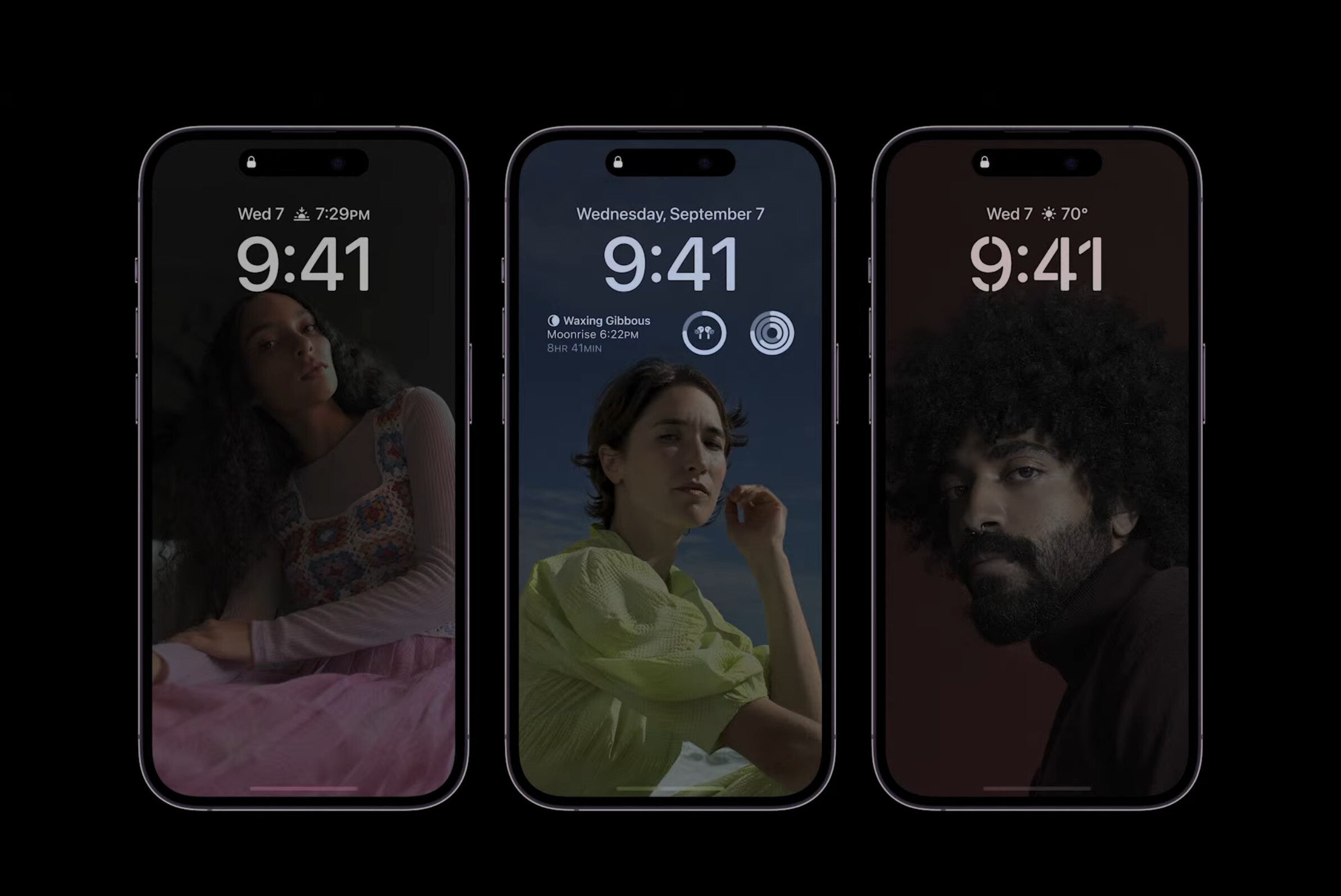
Always On display on iPhone 14 Pro
Both the iPhone 14 and 14 Pro have the flat sides, as before, and glass backs — obviously. Again, the difference here is that the iPhone 14 has a matte-finished aluminum frame and a glossy back, while the Pro has a shiny stainless steel frame and a frosted glass back. What this translates to is — a sticky grip on the iPhone 14, but more fingerprints and a more slippery 14 Pro that doesn’t show as much grease on its back panel (the stainless steel does, though).
On the back, we see the square-shaped camera module on both phones. Obviously, the iPhone 14 only has two lenses there, while the Pro has its stove-like trio and a black LiDAR camera to boot. The Pro’s module is noticeably larger than before (for another year in a row) and it definitely makes a striking impression at first sight.
But, for all intents and purposes, both phones look and feel unmistakably iPhone. It’s up to you to decide whether you want a lighter and brightly-colored, fun iPhone 14, or a more serious iPhone 14 Pro, with a heavier build and more muted, mature colors. Even the exciting Deep Purple color for the Pro line turned out to be kind of dark and subtle.
As for contents in the boxes, we have an iPhone and a USB C to Lightning cable, plus the obligatory booklets. No SIM tray tool in the US, as the iPhone 14 has gone fully eSIM for that market.
Performance and Software
Different chips, for the first time?
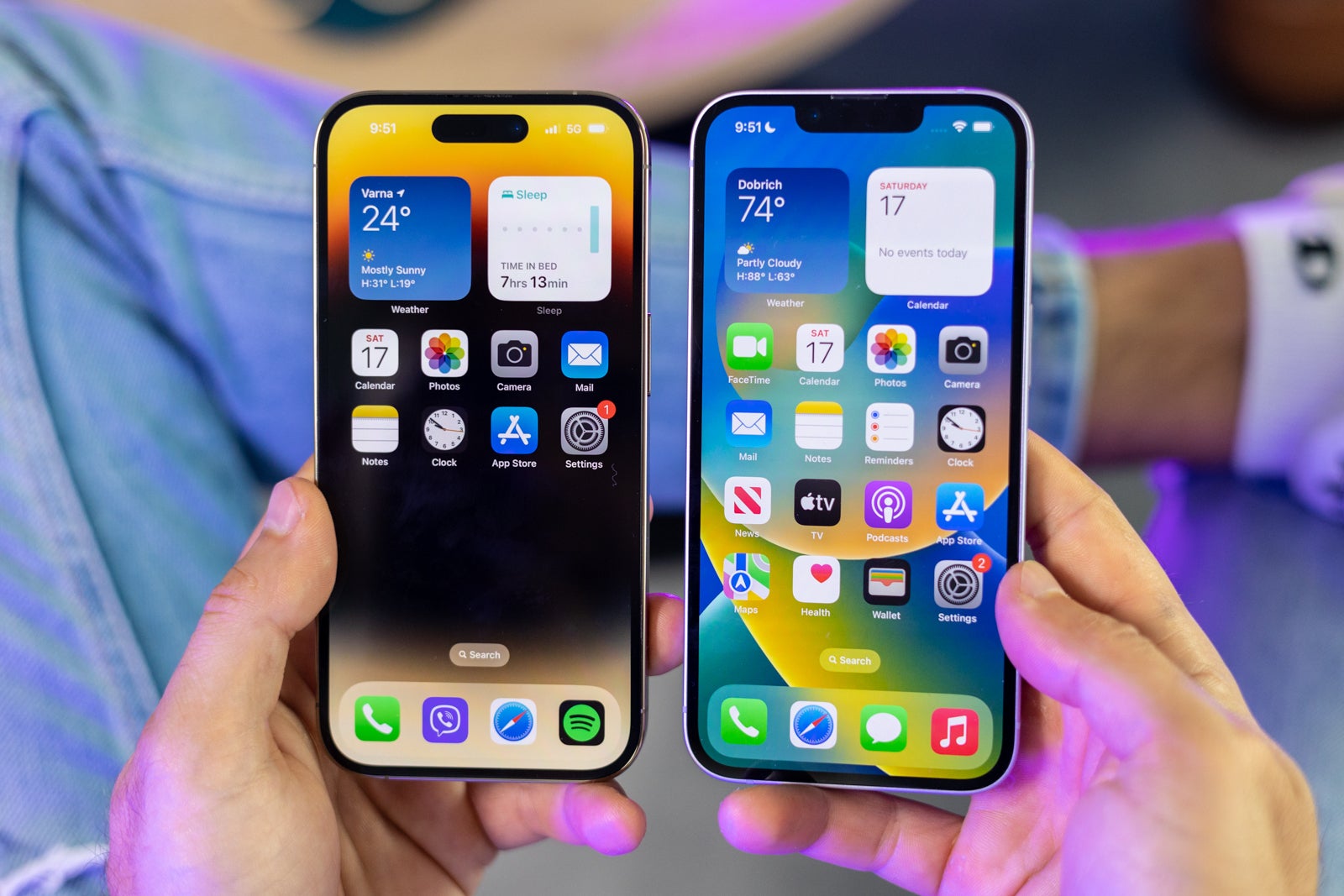
(Image Credit – PhoneArena) iPhone 14 Pro vs iPhone 14
Thus far, main iPhone models that launched together always had the same chipset inside — Apple priding itself in giving Pro performance value to lower-priced models. However, for the first time ever, the iPhone 14 stuck with the old Apple A15 Bionic (the 2021 chip), with a slight upgrade — it has an extra GPU core.
The iPhone 14 Pro got the real update — the new Apple A16 Bionic, built on a 4 nm process with a nice hump in performance and energy-efficiency.
Benchmark Results:
To be clear, the A15 Bionic is still an excellent chip that has plenty of juice left in it. But we are kind of scratching our heads at why one would buy the iPhone 14 instead of going for the cheaper, and very similar, iPhone 13. Or hey — even the iPhone 12, which still trucks along just great. The 14 Pro — now that’s a purchase that’s better justified, with the added performance and camera upgrades (coming up next).
Camera
A small step for the Pro, no leaps for the non-Pro
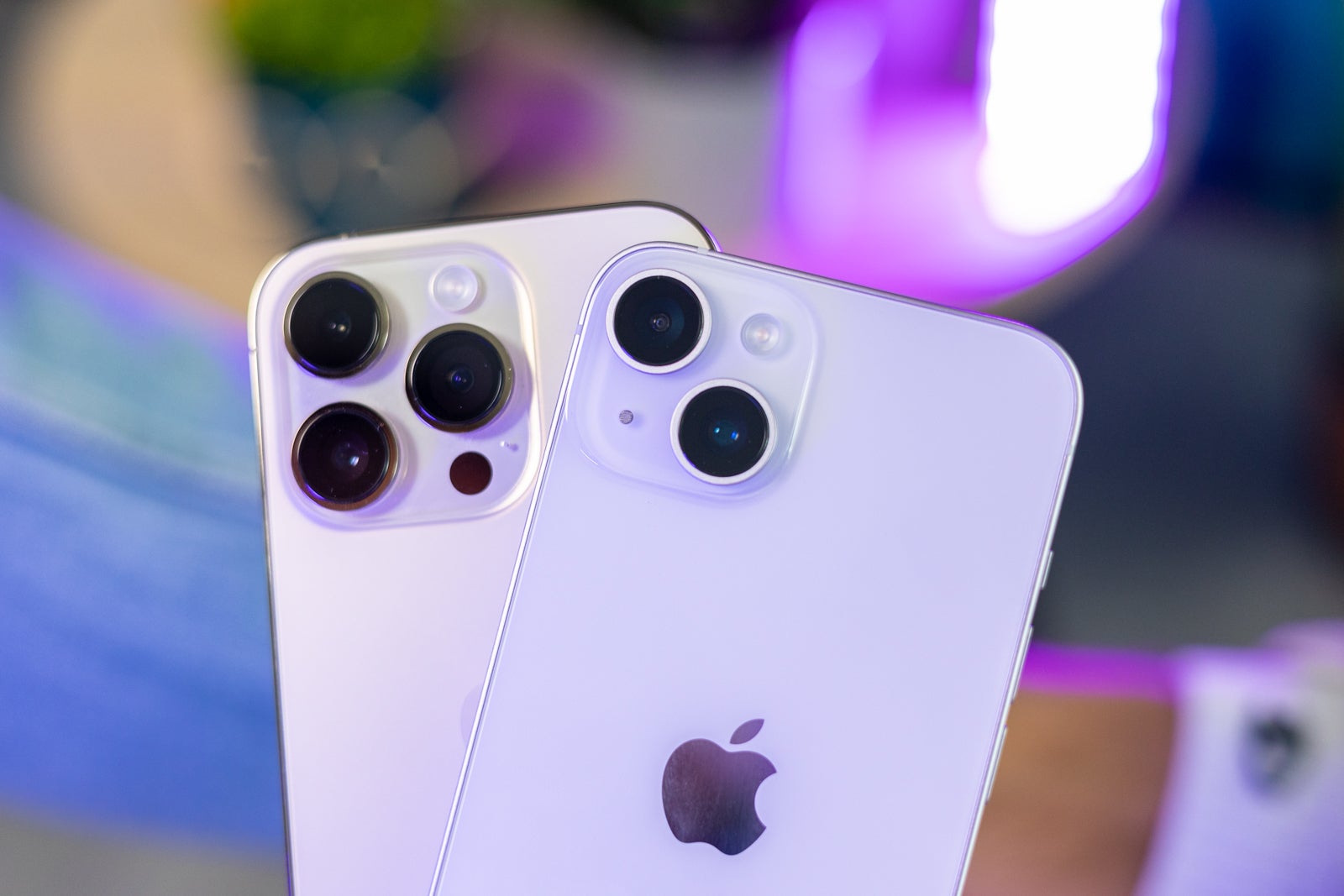
(Image Credit – PhoneArena) iPhone 14 Pro vs iPhone 14
Another place where the two differ is the camera module. Apple has a shiny new 48 MP sensor to fit under the main wide-angle lens of the iPhone 14 Pro. By default, it bins pixels in groups of 4 to produce 12 MP photos just like before, but with much better light sensitivity and less noise. When shooting ProRAW, you get to take 48 MP photos for extra-fine detail, which do look fantastic but you will need some know-how to actually edit them in post.
We can see a good amount of sharpening being done by both phones. With the iPhone 14, it’s apparent that the phone didn’t have a lot of data to work with — at least when we compare its photos right next to the 14 Pro’s. The latter has much more definition in the textures of finer shapes and stripes (look at the umbrella in sample 2, or the disco ball in sample 3). However, with pixel-peeping set aside, we can say that the photos do look very, very similar in terms of colors and dynamics.
Invalid image meta
Invalid image meta
Of course, the iPhone 14 Pro also has a telephoto lens with a 3x relative zoom, making for a great portrait camera. But we also get access to a new 2x zoom option — Apple uses that 48 MP sensor to crop in and give you a 2x step with improved quality. The iPhone 14 only does zoom by digitally cropping into an image. And, of course, the results are obvious — the Pro has a much higher-quality zoom:
The very first scene doesn’t show us a difference in the handling of dynamics — the underside of the umbrella is dark for both cameras. But, the 14 Pro’s ultra-wide has sharper detail there. Also, the sky in the 14 Pro shot is a much more natural shade of blue. The second scene shows us more noise seeping into the iPhone 14’s ultra-wide, and also more blooming and unnatural lighting around the colored bulbs and neons. The third shot is more challenging and both ultra-wide cameras are getting softer and darker, but the 14 Pro held on a bit better. So, yeah, the iPhone 14 Pro has a slightly better ultra-wide camera than the iPhone 14.
And, of course, the iPhone 14 Pro will have that LiDAR sensor, which helps for virtual measurements of the real world. The Ruler app is more accurate, AR apps can take advantage of it et cetera. It has been on iPhones since the 12 series, but we still haven’t seen a major breakthrough with them, so we can’t say it’s a strong selling point.
Audio Quality and Haptics
Apple has been on the top of their game with audio and haptics on iPhones for years now. Usually, the Max models get the best sound, which is easily explained by the fact that they provide more acoustic space for the speakers. But the iPhone 14 and iPhone 14 Pro definitely have a great sound coming out of them, especially considering their size. They are sufficiently loud and offer crystal-clear listening, be it for talking head videos or soundtracks.
Battery Life and Charging
Consistency is key
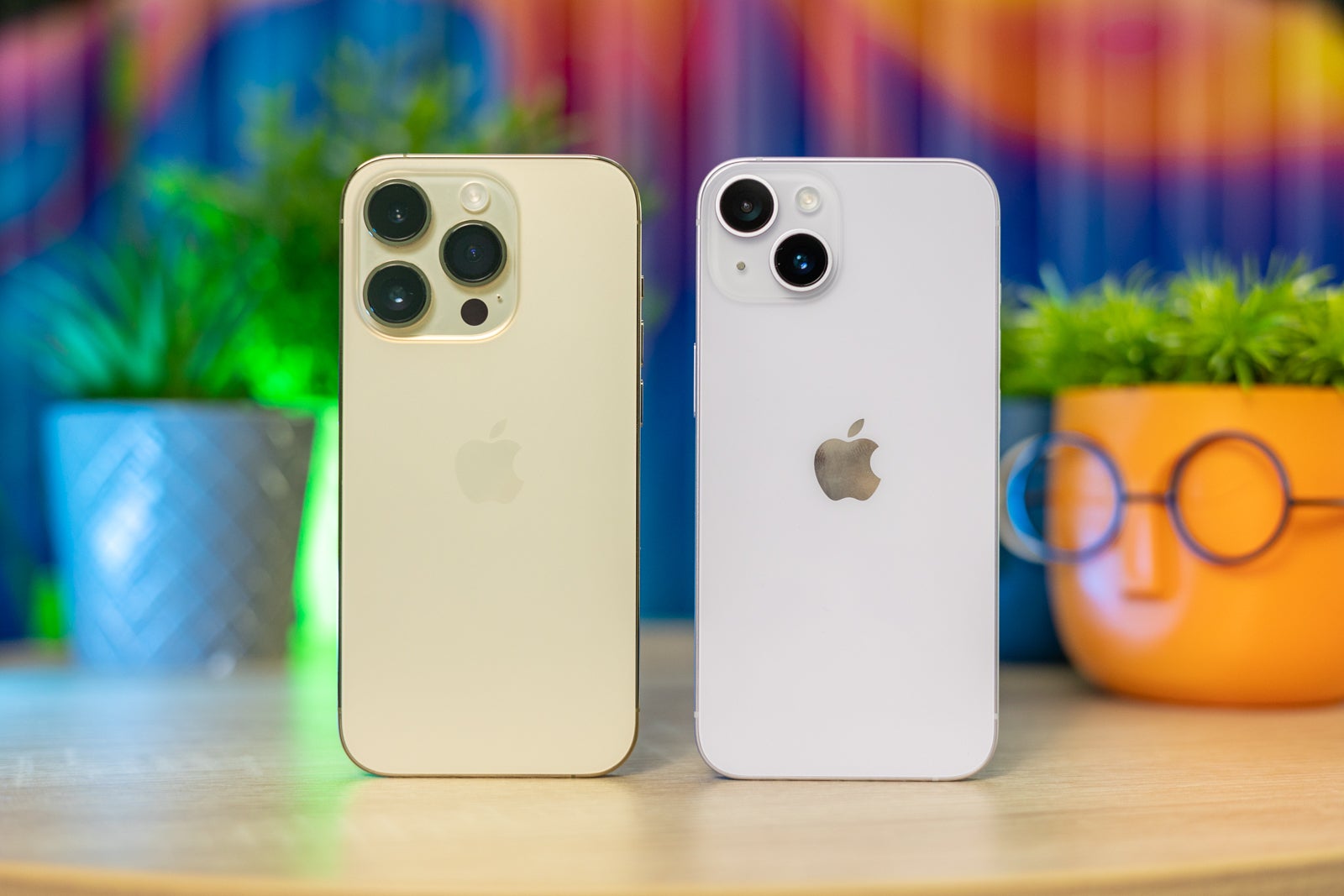
(Image Credit – PhoneArena) iPhone 14 Pro vs iPhone 14
Apple always aims for that “All day battery life” statement — about 10 hours of mixed usage and tons of standby stamina is what you get from an iPhone. And we expected nothing less from the iPhone 14 series.
As per Apple’s numbers, the iPhone 14 can play streamed video for 16 hours straight, while the iPhone 14 Pro does the same for 20 hours, which is quite the gap in performance. Interestingly, the iPhone 14 has a 3,279 mAh battery, while the iPhone 14 Pro has a 3,700 mAh one. Needless to say, we ran them through our tests:
PhoneArena Battery Test Results:
So, we see a much smaller difference here. Indeed, when it comes to browsing or video, the iPhone 14 Pro can last for a bit longer, probably thanks to the efficiency of the 4 nm A16 Bionic. However, when it comes to gaming, that 120 Hz screen sure takes its toll, dropping the Pro’s stamina well below what the iPhone 14 is capable of.
Both the iPhone 14 and iPhone 14 Pro support 20 W fast charging, which should charge from 0% to 50% in about 30 minutes, as per official numbers.
Specs Comparison
| Specs | iPhone 14 | iPhone 14 Pro |
|---|---|---|
| Dimensions | 5.78 x 2.82 x 0.31 inches (146.7 x 71.5 x 7.80 mm) | 5.81 x 2.81 x 0.31 inches (147.5 x 71.5 x 7.85 mm) |
| Weight | 6.07 oz (172 g) | 7.27 oz (206 g) |
| Screen | 6.1″ OLED, 60 Hz, HDR, 1200 nits peak | 6.1″ OLED, 120 HZ, HDR, 2000 nits peak |
| Processor | Apple A15 Bionic, 5 nm | Apple A16 Bionic, 4 nm |
| RAM | x | x |
| Rear Cameras | 12 MP wide, F1.5 12 MP ultra-wide, F2.4 |
48 MP wide. F1.78 12 MP ultra-wide, F2.2, macro 12 MP telephoto 3x, F2.8 |
| Front Camera | 12 MP F1.9, Autofocus | 12 MP F1.9, Autofocus |
| Battery Size | x | x |
| Charging Speeds | 20 W wired 15 W MagSafe 7.5 W Qi wireless |
20 W wired 15 W MagSafe 7.5 W Qi wireless |
| Price | $829 | $999 |
Summary and Final Verdict
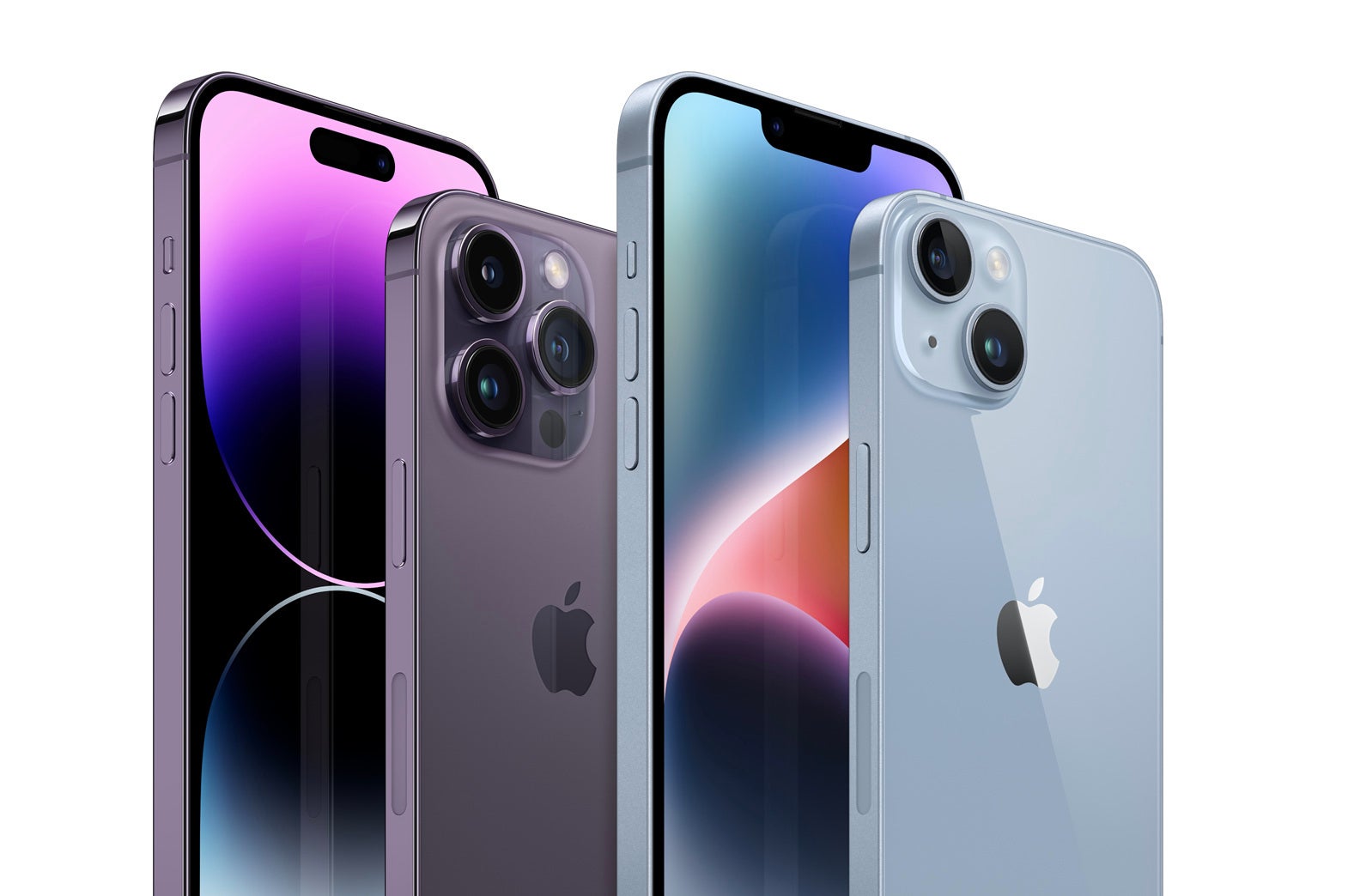
So, no surprise here, the iPhone 14 Pro is the clear winner — it’s more powerful, it has more new features to get excited about, and it feels like the actual new phone. Anyone pining for an iPhone 14 can just save a few bucks and go for a cheaper iPhone 13 instead. The iPhone 14 is more a retreading of old ground, while the Pro actually adds some new features, a much needed camera upgrade (and impressive ProRAW performance), and a new user experience, with the Dynamic Island.
Are these new features worth an extra $200? Maybe, maybe not, but then we also have the other features that are exclusive to the Pro line — 120 Hz screens, a telephoto camera for great portraits, 4K ProRes video recording — the gap between the Pro iPhones and the non-Pros has widened. And for the first time in a while — that price uptick seems to be worth it. Or is that simply because the regular iPhone 14 didn’t bring much to the table?
For all the latest Technology News Click Here
For the latest news and updates, follow us on Google News.

